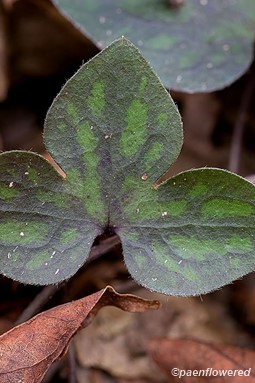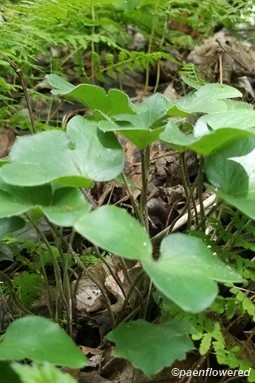Hepatica acutiloba
Hepatica acutiloba sharp-lobed hepatica
Add to MyPlants View Locations
This low-growing native wildflower is named for the shape of its leaves. These leaves have three lobes and thus resemble the human liver - hepatica is the Latin word for 'liver'. Early herbalists assumed that since the leaves of the plant resembled the liver, it could be used to treat liver disease. This is part of the antiquated “Theory of likes.” There is no actual evidence that any extract from hepatica can be used to treat liver problems.
There are two closely related species of hepatica in the state, the sharp-lobed hepatica and the blunt-lobed hepatica (Anemone americana). Both have flowers that range in color from white to pink to lavender, but differ mainly in the shape of the tips of the leaves and bracts. In their early stages of growth it is not easy to tell the difference unless you can see the old leaves from the previous season. During the winter the leathery old leaves often persist, turning violet or brown. Sometimes these are so damaged it is hard to tell what kind of tips they may have and they may be hidden under leaf litter. If the old leaves are not visible, the shape of the bracts behind the flowers can identify each species. They often are in the same shape as the lobes of the larger basal leaves.
The new green leaves appear during or after the flowers bloom. These leaves are 2-2 ½ inches wide. The leaves tend to lie close to the ground while the several hairy flower stalks are usually near vertical. Each flower is ½ to 1 inch in diameter. There are no true petals, but the sepals have the appearance of petals. The number of these sepals may vary from 5-12. Stamens are numerous. Beneath the sepals are three green bracts that resemble sepals. The tips of the leaves and bracts of this species are pointed.
The plant grows to a height of 4-6 inches and is usually found in dry rocky wooded areas. It is one of the earliest flowers to bloom in the spring. The blooming time is from March to June depending on location and weather. The fruit is hairy and seed-like and contains one seed.
The blunt-lobed hepatica occurs throughout much of the eastern half of North America. It often emerges about a week later than A. acutiloba. Both species are closely related to the European Anemone nobilis and biologists once considered them to be varieties of that Old World species. All are now considered to be distinct species.
Habitat & Range
Common in upland woods and rocky slopes; prefers calcerous soils.
Present throughout the state except the southeast.
Wetland code: Not classified
Phenology
Flowers early April through May.
Plant Codes
S-rank: No rank
G-rank: G5 (Secure)
Hepatica acutiloba sharp-lobed hepatica
Synonyms: Anemone acutiloba, Hepatica nobilis var. acutaAdd to MyPlants View Locations





.jpg?v=638488336510000000)



Comments
Have you spotted this plant in your area? We'd love to hear about your experience! Share your comments or questions about the plant below. Comments are moderated before posting.